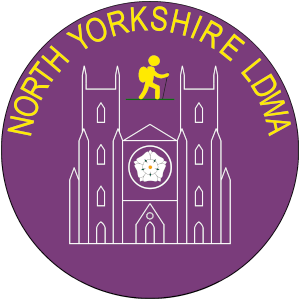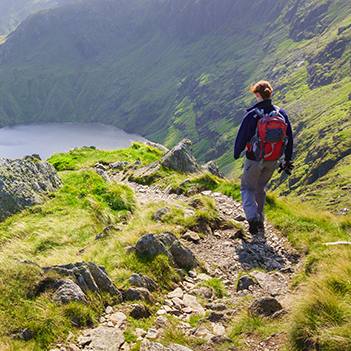Moonlight Night Walk 2 Spoons 6, Scarborough to Whitby | Friday-Saturday 19-20 April 2019
| Walk Leader: | Steph Carter |
| Participants: | 8 |
| Mileage: | 24 miles |
| Walk Register: | Yes |
| Walk Report: | Steph Carter |
8 of us walked on what was a simply glorious night - clear, allowing the moon to illuminate the route in eerie, but vivid black and white, then a most fantastic sunrise over the North Sea.
The route was a simple one. 12 miles of cliff top walking along the Cleveland Way , 5.5 miles of the "Cinder Track" (the old railway bed of the very first East Coast Mainline which avoided York, and linked Scarborough and Whitby) then a further 7 miles of cliff tops.(again the Cleveland Way, including 3 miles shared with Wainwright's Coast to Coast walk)
The North Yorkshire cliffs are often high, and undulating, with, sometimes to the distress of the walker, an occasional steep drop and climb to cross a valley. In a full moon the cliffs and headlands appear clearly as spectacular yet sinister shadowy grey masses, with the gentle waves of a calm north sea also visible.
Occasionally the torches of a beach fisherman flashed on the shoreline, while the trees, bent by onshore winds past, and golden gorse bushes appeared in exaggerated beauty in our head torch beams. This is truly a cliff top walk, as, once leaving the promenade of Scarborough's North Bay (having already skirted the giant promontory on which a floodlit castle exudes its authority over the town) the route did not get back to sea level until Whitby. While it crossed many valleys none of these had cut completely down to the sea, so either ending with a waterfall or dryness dropping away to the sea. The deepest cut, Hayburn Wike, about 8 miles in, almost reached the sea, and provided us with a rest stop some 20 feet above the shore, having descended hundreds of feet to get to this low level ledge, only to have a lung busting climb back up the cliff top again.
4 more miles of undulating walking saw us reach Ravenscar. A village of a few hundred people abandoned by history. When the original railway line was built in Victorian times it was the mainline, and this was to become Britain's first new town - high on cliffs, looking over Robin Hoods Bay to the north few places are more beautifully set. Plans were drawn up, and, with typical Victorian water management efficiency a sewage farm for a population of 20000 people was built... and all was set... only for the new North East coast mainline route through York to usurp the original line passing through Ravenscar through being far quicker. Ravenscar plans were quickly abandoned, so a village of 200 survives, a monument to the false optimism of expansion on the back of an about to be abandoned railway line.
While the clifftop route continued to Robin Hoods Bay by dropping down to the shore line, we avoided this, and instead followed the section of the "Cinder track" railway bed to Robin Hoods bay. As we neared Robin Hoods Bay the occasional hoot of an owl gave way to a dawn chorus, interrupted, rudely, by cacophonies of seagulls. A low wall in the cliff top part of Robin Hoods bay, with the very first evidence of dawn in the sky ahead of us, and a setting full moon behind us, gave us our last rest, before moving on again on the cliff tops for the last 7 mile section to Whitby.
While this was slightly less up and down than the previous section of cliff top, it still undulated. Each horizon giving us a new headland or a new horizon. To our east the sky was turning orange, pink and golden as dawns light intensified, and then a vivid orange sun appeared first as a segment, then growing into a full orb above the North Sea. The distance flash of Whitby lighthouse had ceased in the daylight as we drew nearer to it then to pass it, together with the nearby giant horns of the fog warning system.
Fully light now, the babbling murmur of skylark song accompanied us as, at last, the ruins of Whitby Abbey came in to view. After a caravan site the turfy cliff top path gave way to a more managed gravel path and as we drew near to Whitby Abbey the town, on both near and far banks of the Esk (the only river to flow into the North see between the Tees and the Humber) came into view below us. Lots of steps down, a walk through the narrow and trendy cobbled Whitby streets (with many Whitby Jet jewellery shops) took us to harbourside, to cross the swing bridge to the destination pub for breakfast.
While Scarborough is a large busy resort - claiming, in competition with Brighton, to be the world's original seaside resort, Whitby, once it's poorer and smaller neighbour has become much more trendy. Whitby Jet - fossilised Monkey Puzzle trees - was made popular by a mourning Queen Victoria. In 1890 Bram Stoker's visit to the town, with its gothic architecture and ruined abbey, inspired the creation of Dracula. This in turn, has given rise to a world leading annual Goth festival. Then of course there is Whitby Fish and Chips - without doubt the finest anywhere on the planet.
A wonderful walk in perfect weather.
Photos by Wendy Leete




















